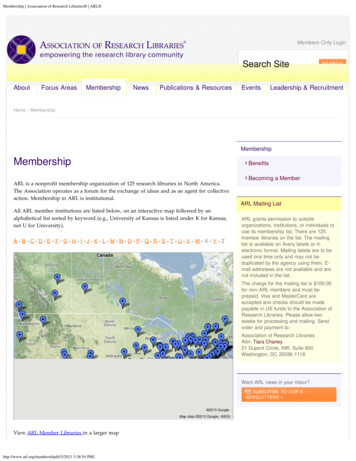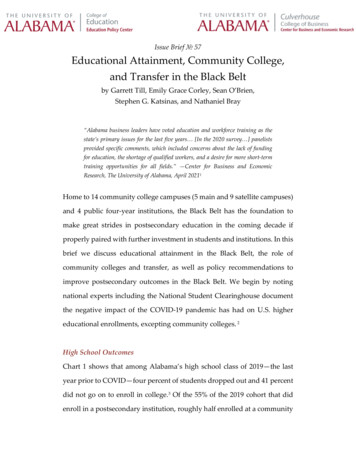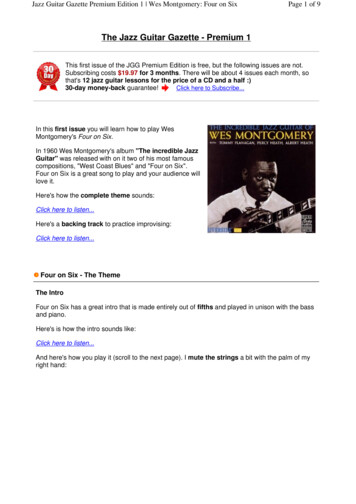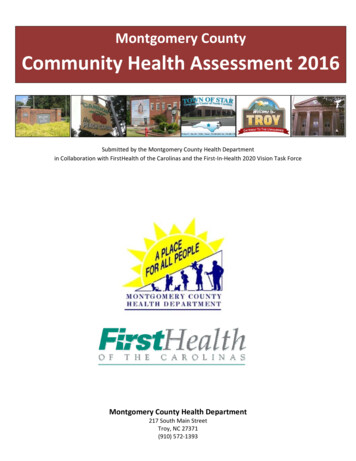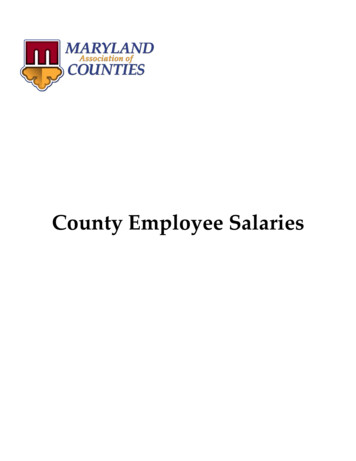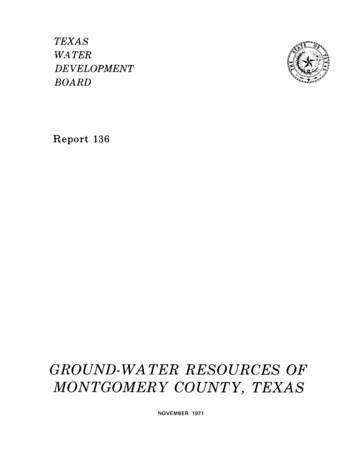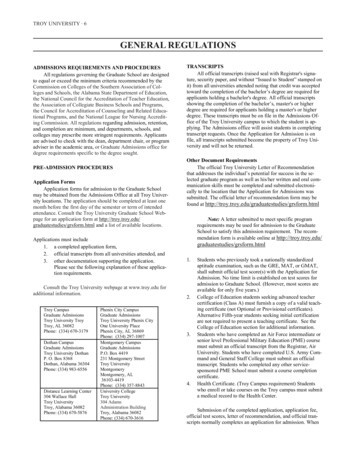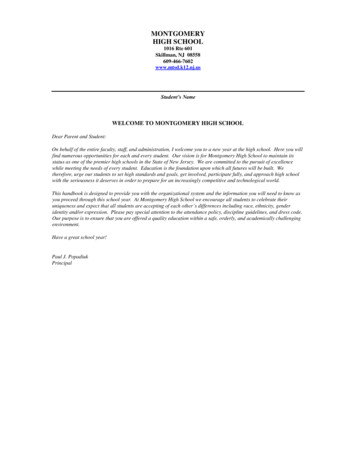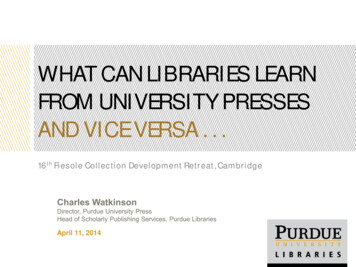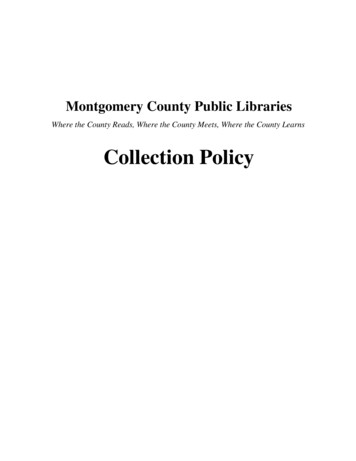
Transcription
Montgomery County Public LibrariesWhere the County Reads, Where the County Meets, Where the County LearnsCollection Policy
Executive SummaryThe Montgomery County Public Libraries’ Collections Policy presents the strategies to develop,expand, diversify, and build 21st Century library collections to meet the library needs andexpectations of the Montgomery County residents/communities.Collections Policy Objectives: To provide well-rounded and balanced collections which are comprised of new andpopular materials; reference tools; materials that assist in life-long learning; andmultilingual materials. To formulate cooperative agreements with organizations and groups to expand theLibraries’ capacity to make more information and resources accessible to residents. To continue the Libraries’ tradition of staying abreast of new and emerging resources;and, then to incorporate them into the collections as appropriate. To ensure intellectual freedom for all users.The following chapters will present guidelines used by MCPL to fulfill these objectives. Materials Selection Cooperative Agreements Materials Deselection Intellectual FreedomIntroductionThe mission of Montgomery County Public Libraries is “to offer free and equal access toservices and resources that connect the people of Montgomery County to ideas and informationwhich sustain and enrich their lives.”The Collection Policy reflects the mission of the Libraries. The Collection Policy serves as aguide to staff in the selection and retention of materials. It also provides the public informationabout the principles which support selection decisions. The Libraries’ users consist of manydifferent types: early literacy age levels from birth to 5 years old; students from K-12; as well ashigher education levels; ethnic communities; Seniors; the visually and hearing impaired; thehomebound; local businesses; and prison inmates.The Montgomery County population, which was 971,777 in 2012, will continue to increase anaverage of approximately 9,200 persons each year throughout the next eight years reaching overone million by 2014 and nearly 1,045,400 by 2018. There were 357,086 households in the2
County in 2012, and current projections estimate the number of households will increase to364,900 in 2012. The County’s Senior population continues to grow with an estimated 119,769persons 65 and older living here in 2010 and projected to increase to 154,061 by 2020. TheCounty expects the public school student enrollment to increase by 7,062 between FY13 andFY18. The increase in diversity from 2000-2010 resulted in the County becoming a majorityminority county for the first time.This large diverse population possesses an unlimited range of interests. With a limited budget,Libraries must make decisions on how to best serve these myriad of interests. Therefore,Libraries has developed cooperative agreements or partnerships with other libraries to expand itscapacity to make more information and materials available to residents which might not haveotherwise been possible.Montgomery County is fortunate to be surrounded by many high performance schools fromelementary to universities; as well as numerous specialized libraries such as the National Libraryof Medicine, National Institute of Health, Library of Congress, National Agricultural Library,etc. With these easily accessible, MCPL does not purchase textbooks or in depth researchmaterials.Collection Management’s annual workplan will delineate a variety of activities which willincrease the communication and collaboration with staff and customers in the pursuit of thedevelopment of “relevant and inspiring collections that meet the evolving needs and expectationsof our communities.”1. Materials SelectionThe Director of Montgomery County Public Libraries (MCPL) is responsible for the collectiondevelopment of the libraries. Authority for decisions on selection, maintenance, and withdrawalof materials is delegated by the Director to the manager and staff of the Collection Managementdivision. The Collection Policy serves as a guide to staff in the selection and retention ofmaterials. It also provides information to the public about the principles which support selectiondecisions.Basic to the Policy are the American Library Association’s Library Bill of Rights, Freedom toRead Statement and, the Freedom to View Statement. These statements pertain to allinformation formats, including print, video, audio, digital and electronic formats.Libraries assure that the collection is open and accessible to all residents. Libraries is committedto a collection which presents a variety of points of view on all subjects. Libraries seeks to meetthe community’s needs, and recognizes that some materials may be controversial. It is theresponsibility of each library user to choose materials which suit their individual tastes andneeds. Individuals are free to reject materials for themselves that they do not approve; but theymay not restrict the freedom of others to read, listen, or view materials for which they areinterested. Responsibility for children’s use of library materials rests solely with their parents orcaregivers.The primary objective of MCPL’s materials selection is to provide well-rounded and balancedcollections comprised of new and popular materials; reference tools; materials that assist in3
lifelong learning; and multi-lingual materials. The collections are meant to anticipate, supportand respond to the diverse informational, cultural and leisure needs of community residents of allages.Collection Management librarian selectors apply their knowledge, judgment and expertise inselecting materials along with the following standard criteria. An item need not meet all criteriato be selected. Selectors also consult reviews, bibliographies and other evaluative sources.General Selection Criteria Relevance to current and anticipated community needs Intended audience Suitability of subject and style for intended audience Critical reviews and other evaluative sources Number and nature of requests from the public Relation to the current collection and other materials on the subject Reputation and qualifications of the author/artist and/or publisher/producer Local significance of the author or topic Comprehensiveness of treatment Representation of majority and minority points of view Usefulness to patrons with special needs Relevance to the experiences and contributions of diverse populations Quality of illustrations and effective characterizations Suitability of physical form for library use CostSelectors determine the distribution and number of copies to branches based on anticipateddemand, input from branch staff, physical space available in branches, local interests, andbudget. Libraries recognizes that users have differing abilities and backgrounds, and therefore,provides materials of varying levels of difficulty.Branch library collections are developed to meet the informational, educational and leisure needsof their specific communities. These needs are continually assessed by selectors and branch staffthrough the review of census data; evaluation of the use of the collection; monitoring communityinterests and activities; monitoring other services and programs available in the community; andcollaborating with appropriate neighborhood organizations and schools. Evaluation tools, whichassist in assessing the collections, include various reports from the Libraries’ circulation systemand CollectionHQ. CollectionHQ is a software application that is used to gather and analyzelibrary circulation data from which system and branch level reports about the collection’savailability, currency, condition, and use throughout the year are generated. CollectionHQ willhelp Collection Management and branch staff to determine customers’ usage patterns; as well asto weed collections to keep them fresh and relevant. Branch library collection profiles areupdated periodically to determine any significant changes within the local communities (e.g.more families, seniors, or preschoolers, a change in ethnic populations).Each library has staff whose primary responsibility is the management of the branch collection.This staff, which interacts directly with customers, will work closely with CollectionManagement selectors in the development of strong local collections through ongoing4
communication. Selectors will solicit input and feedback from branch staff on a variety of topicsabout local needs.Libraries also encourages continuing input from residents. A customer “suggestion forpurchase” form and a general “comment and suggestion” form are available on the Libraries’website and at all library agencies. Regular feedback is solicited from members of the LibraryBoard and Library Advisory Committees (LACs). In addition, staff will meet with LibraryAdvisory Committees, Friends of the Library chapters and sometimes community groups togather ideas about their new or renovated library collections’ focus. Guidelines for authors orpublishers who are asking Libraries to consider the purchase of their material(s) can also befound on the Libraries’ website (Information for Authors and Others Submitting Work forConsideration by MCPL).Electronic ResourcesElectronic resources provide opportunities to expand the scope of information and materialsavailable to users. Electronic resources include internet sites, databases, and e-books. Streamingof movies and music sites is fast becoming a popular new electronic format which Libraries willcontinue to investigate. Libraries have been in the forefront in the provision of new formats andtechnology for reading and information to its users. The impact of information in digital formatsand library users’ expectations to access them through their local libraries has increasedtremendously.E-books are defined as digital objects specifically designed to be accessible online and read oneither a handheld device or a personal computer. MCPL subscribes to downloadable e-booksthrough Overdrive and e-audiobooks through OneClick Digital. Libraries also providesnumerous non-downloadable e-books purchased through various publishers and vendors. Ebooks can facilitate information discovery through search features, expand collections, savespace, and reduce costs. Customers have the option of either checking out an e-book, viewing itonline, or viewing it offline by downloading it onto their personal computers, e-readers, tablets,and a variety of handheld devices.While the general Selection Criteria of traditional formats also apply to electronic resources,additional selection criteria need to be considered in the acquisition of electronic resources.Electronic Formats Selection Criteria Quality, relevance, currency, comprehensiveness and accuracy of information Ease of use Availability to multiple users, usually simultaneously Ease of navigation and training requirements Hardware and software requirements Technical support Remote access availability Enhancement of print equivalents in terms of speed, flexibility, and full text availability Reduction or elimination of the purchase of multiple copies for multiple locations Updating frequency Purchase or lease Cost5
The increasing use of electronic resources presents different challenges for analysis. Thestandard methods of analyzing a collection cannot easily be applied in the analysis of electronicresources. Many electronic resources do not circulate; circulation of some e-resources issometimes limited by the publisher/vendor. The circulation of most of these resources is notincluded in the Libraries’ circulation system, only through vendor data reports. The reportsprovide the following data elements: number of sessions (logins); number of searches; numberof materials downloaded; and the number of turn-aways. Circulation, cost-effectiveness, alongwith the increasing demand by users, and analysis of how successful the users’ needs are metshould also be considered. Tracing usage patterns is increasingly important as more funds aredevoted to electronic resources.E-books in public libraries changed radically in the beginning of 2011. With the increased saleof e-readers during the holiday season at the end of 2010, public libraries experienced asubstantial jump in e-book use. The American Library Association’s 2012 State of AmericanLibraries Report states that “The proportion of U.S. libraries that made e-books available almostdoubled over the past five years, climbing from 38.3% in 2007 to 67.2% in 2011.” In FY11,MCPL had an 89.71% increase in circulation of downloadable e-books and e-audiobooks. In thecoming years, increased usage is expected to continue to rise at startling rates, raising a host ofchallenges, opportunities and new realities for MCPL and other public libraries.The e-book industry is in a state of rapid flux and rapid growth with new developing trendswhich will push libraries to implement new collections, services, and lending solutions. Withnew entrants into this industry and major advances of current players, assessing what is on themarket can be a challenge. MCPL will need to stay informed and engaged in this ever-changinge-book market. Libraries’ users have high expectations in having libraries provide more ebooks,which is complicated by budgetary restraints. Being familiar with the myriad of issues willassist MCPL to make informed decisions about better systems for e-book and e-reader use. Itwill also assist Libraries in the provision of a balanced collection of print and electronic books.World Languages CollectionsMCPL currently has Chinese, French, Korean, Russian, Spanish and Vietnamese collections atvarious branch libraries throughout the County. These collections are popular browsingcollections of books, magazines, and newspapers that provide leisure reading to children andadults. These collections reflect the literature and interest of multiple cultures living in theCounty. These collections are not intended to offer the breadth of information offered in theEnglish language collection. The primary audience is recent immigrants who need practical,educational and recreational reading for themselves and their children in their first language.Speakers of English who are students of another language, especially students in theMontgomery County Public Schools, are a second target group. The Montgomery County PublicSchool system reports that students come from 164 countries and speak 184 languages. Ofthese, 13.1% participate in English as a Second Language (ESL) classes. MCPL providesEnglish as a Second Language (ESL) CD-books, DVDs, workbooks, and two databases thatassist foreignborn users to learn English. More and more databases that Libraries provide alsohave the capability to access the information in a user’s native language.6
The languages currently in the collection represent the largest linguistic groups of newimmigrants in the County as determined by the U.S. Census Bureau, 2010 American CommunitySurvey, Maryland National Capital Park and Planning Commission and Montgomery CountyPublic School data.Montgomery County’s population projections for FY12 to FY18 reveal that its population willcontinue to increase and become more diverse, both ethnically and racially. The increase indiversity from 2000-2010 resulted in the county becoming a majority minority county for thefirst time.During the next four years, location or relocation of these world collections, as well as theaddition of any new language collections or a new site will be determined by the followingcriteria: The review of the most current census demographic information.The percent of the speaker population in the community. Libraries will work with theOffice of Community Partnerships on an annual basis to determine this percentage whichis based on current census data for Montgomery County.Level of participation in County ESL programs and related programs for immigrants.Expressed demand, including individual requests from groups, ESL teachers andprograms, and branches. Patterns of these requests will be used to guide the addition ofselected magazines, donated materials, small collections of children’s and other targetedmaterials; and to determine which languages merit a browsing collection.Immersion programs in service areas and other patterns of demand by speakers of Englishwill be considered in determining the need for small focused collections.Libraries’ budget, the cost of purchasing materials fully processed, or the capability andcost of purchasing bibliographic records.Availability of databases in world languages that will serve a wide range of customers.Availability of grants, endowments, etc. to establish new world language collections.The increased growth of e-books offers a viable solution to the inclusion of additionalworld language materials into the MCPL collection.MCPL will also work closely with the Office of Community Partnerships and the LiteracyCouncil of Montgomery County in the development of future world languages collections. TheOffice of Community Partnerships coordinates the County’s efforts to monitor, evaluate andimprove its services to the County population with limited English proficiency (LEP).Montgomery County has a policy that requires agencies serving the multilingual population tomake reasonable efforts to provide language-appropriate services in some of the most usedlanguages in this County.GiftsGift materials are accepted with the understanding that the same standards of selection areapplied to gifts as applied to materials purchased for the collection. Gifts are accepted with theunderstanding that they may not necessarily be added to the collection. Gifts, which can expandownership and availability of titles in the Libraries’s collection, will be accepted and placed in7
branches throughout the system. Gifts not added to the collection may be sold by the Friends ofthe Library, Montgomery County, Inc. or its chapters. Proceeds are used to enhance libraryservices in the County. Libraries reserves the right to the disposition of the gift materials.Libraries may choose not to accept some gifts.Some general guidelines in the acceptance of gifts are: materials should be no older than threeyears old; materials must be in good condition; limited magazine titles are accepted; textbooks,encyclopedias and curriculum materials are not accepted. Libraries will give a donor anacknowledgement of receipt, which may be used for tax purposes, stating the number and typesof materials, but not their value. It is the donor’s responsibility to determine the value of theirmaterials.Gift materials and funds are often given in memoriam. In this case, prospective donors shouldcontact the manager of the Collection Management division to discuss the various aspects ofthe gift.Local Authors ProgramThe Local Authors Program provides an ongoing way for Montgomery County residents whohave published books to be part of the cultural conversation of the community, where the workwould not otherwise by selected for inclusion in the Libraries’ collection. A single copy only, ofa book by a Montgomery County resident, may be sent to the Cataloging and Processingsupervisor to receive a brief catalog entry and minimal processing. The book can then be placedon a Local Authors Shelf in the branch designated by the resident without further evaluation forinclusion in the collection. Library managers may choose to begin a Local Authors Shelf afterconsulting with the Manager of the Collection Management division.Opening Day CollectionsLibraries uses “opening day collection” in many ways, but ultimately, it always means thecollection that is in the library when the building opens (or re-opens) for the first time. In somecases, the entire collection is new. Libraries also uses “opening day collection” to refer tospecific collections (YA, genealogical, audio books, etc.) as an area that is being highlighted onopening day. The makeup of those collections varies widely.Prior to the closing of a library which is to be renovated or expanded, a checklist should bedeveloped to include the following information: Weed all collections of worn materials. Do not pack and store these materials.Weed outdated materials, i.e. videos which will not go back into the new collection.Assess the need to move specific collections before the branch’s closure to other brancheswhich will be impacted. Identify those popular and high demand materials to be moved.Determine the highest circulating collections (book stock, percentage of total collection,turnover rate).Identify new collections or collections which need expansion as identified in the FacilitiesProject Specifications. (Ex. if a small business focus is planned determines number,types and currency of already owned materials.)8
Collect subjects or titles for which customers are asking but are not currently owned byLibraries. This information will help when developing the opening day collection.Looking to the future, Libraries’ print collections are being reduced in favor of electronicresources which provide more convenience, improved access, and the reduction of physicalspace which is usually needed to house a print collection. MCPL and other libraries are realizingthat customers are seeking other uses of library space such as small and large tutorial rooms,discovery rooms, computer labs, etc. Reference and magazine collections which requirecontinual updating and currency are the collections which can best be changed from print toelectronic. Opening day collections of new or renovated MCPL branches should look todiscontinue these print collections and provide electronic access. Current print magazinesubscriptions are already offering them online simultaneously. To enhance this new magazineservice, it will be necessary to also purchase handheld devices to allow customers to easilyaccess and read “ezines.” MCPL currently has some reference materials available electronically.Use of reference materials should continue to be assessed to determine other reference materialsthat should be purchased electronically rather than printThe DVD/movie industry is also starting to change due to such new advances such as pay- perview, streaming, Netflix, etc. Some Maryland public libraries have already seen a decrease incirculation of their feature films and an increase in network, PBS and cable television shows.Collection Management will need to closely watch this market and any changes in thiscollection’s circulation and adjust the purchase of DVDs accordingly prior to opening a newlibrary.With early literacy as a goal of the MCPL FY17-FY20 Strategic Plan, and the inclusion of“early literacy children’s areas” in new or renovated libraries, children’s materials should bepurchased in quantities to meet the demands of the communities.Merchandising is one of the best ways to market a library’s collection. Self-standing displayunits, end of aisle displays, and ample top and bottom library shelves should be included to allowfor effective merchandising of the new opening day collections.2. Cooperative ArrangementsMontgomery County Public Libraries has many cooperative arrangements with organizationsand groups. The goal of these agreements is to expand Libraries’ capacity to make moreinformation and resources accessible to residents; and, the leveraging of available funds.Resource sharing offers County residents a wide range of historical, research oriented andspecialized materials which Libraries would otherwise not be able to provide. The following is alist of MCPL’s cooperative agreements. Interlibrary loan is the most familiar to users. Materials from libraries across the UnitedStates can be located and reserved through the Maryland State Marina and OnlineComputer Library Center (OCLC) systems.Montgomery County Public Schools – shared school booklists for summer reading9
Library for the Blind and Physically Handicapped – This organization providescomprehensive library services to eligible blind and physically handicapped residents ofthe State of Maryland (e.g. digital books and players, Braille materials).Federal Depository Library Program – As a member, the Rockville Memorial Libraryprovides access to U.S. Government documents online and a selection of printgovernment documents. Libraries’ catalog contains records for the print documentsreceived under the program.Montgomery County Historical Society – This library’s collection holdings are listed inMCPL’s catalog.Maryland Consortium – Provides access to downloadable audio and e-books through theMCPL websiteMaryland state agreement with several database vendors in the provision of specialpricing for Maryland county library systems.3. Materials DeselectionMaterial deselection, or weeding, is the process of removing materials from the active collectionfor withdrawal or transfer. It is an essential element of collection development that ensuresLibraries’ materials are useful, accessible; and, that Libraries continue to maintain qualitycollections. Branch collections are regularly reviewed to assure their currency and usefulness.Some of the guidelines used by staff are: Condition of materialsOutdated materialsAccuracy of informationImprove access to the collection by staff and usersAlleviate space problemsIdentify collection gapsItems no longer of interest or in demandUnused duplicationOther evaluative tools that staff use to make informed decisions about the removal or the transferof materials are reports from Libraries’ circulation system and CollectionHQ. With theincreased use of electronic resources, periodical and reference collections will continue to beassessed to determine the most appropriate format to offer these materials to library users.Withdrawn and discarded materials cannot be given or sold to individuals or organizations.Periodicals and newspapers must be discarded. Materials in poor condition must be recycled.All other materials withdrawn from the Libraries’ collections will be sent to the Friends of theLibrary, Montgomery County, Inc.4. Intellectual Freedom10
Basic to the Collection Policy is the American Library Association’s Library Bill of Rights,Freedom to Read Statement and, the Freedom to View Statement. These statements pertain toall information formats, including print, video, audio, digital and electronic formats.Libraries assure that the collection is open and accessible to all residents. It is committed to awell-balanced print and electronic collection which presents various points of view on allsubjects, controversial or not. Libraries does not remove, restrict or withdraw materials becausethey are regarded as discriminatory or inflammatory by an individual or group. Libraries seeksto meet the community’s needs, and recognizes that some materials may be controversial. It isthe responsibility of each library user to choose materials which suit their individual tastes andneeds. Individuals are free to reject materials for themselves that they do not approve; but theymay not restrict the freedom of others to read, listen, or view what they are interested in.Responsibility for children’s use of library materials rests solely with their parents or caregivers.ConclusionMontgomery County Public Libraries is committed to anticipating future user and communityneeds and expectations to help the Libraries design and provide collections to meet them. Inputfrom the community will continue to be a high priority in the future development of theMontgomery County Public Libraries’ collection. New materials and formats that meet thecommunity needs will be reviewed according to the selection criteria and purchased as resourcesallow. Technological advances, societal values, and cultural differences require flexibility,openmindedness, and responsiveness in the evaluation and re-evaluation of all Librariesresources.11
The mission of Montgomery County Public Libraries is "to offer free and equal access to services and resources that connect the people of Montgomery County to ideas and information which sustain and enrich their lives." The Collection Policy reflects the mission of the Libraries. The Collection Policy serves as a
